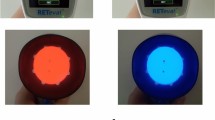Summary
A series of 600 eyes was studied using a Goldmann applanation tonometer and Müller electrotonometer. The equipment was carefully checked to meet the present standards and all measurements were made by the junior author. The Friedenwald 1955 calibration tables were employed. The mean intraocular pressure by applanation was very similar to that by Schiötz tonometer with 5.5 and 7.5 weights (Table 1). Furthermore, when the applanation and Schiötz tensions of the same eye were compared the difference was within -2....+2 mm Hg in 75 per cent of the eyes (Tables 2 and 3). Using regression analysis the following equations were obtained:
In the equation y=Schiötz tonometer and x=applanation tonometer.
Finally, the means and 95 per cent confidence intervals of various Schiötz readings corresponding to given applanation readings were calculated (Figs. 1 and 2). Fig. 1 reveals that e.g. the corresponding Schiötz value of an applanation reading of 11 mm Hg is 12.9 mm Hg with a confidence interval of 12.2....13.6. The applanation reading of 20 mm Hg has a corresponding Schiötz value of 19.3 with a confidence interval of 18.7....20.0. The figures show that on lower pressure levels the Schiötz readings are higher and on higher pressure levels lower than the corresponding applanation readings. This would explain the good agreement of the mean values. While the intraocular pressure is higher in the supine position of the order of 1 to 2 mm Hg, the effect of posture makes the disparity even greater. If the effect of posture is taken into account, the Schiötz method should yeild values which are 1 to 2 mm Hg higher than the corresponding applanation values. This would be the case if the 1948 calibration scale is used. In higher pressure levels both with 5.5 and 7.5 gm weight the intraocular pressure estimates would be about 1 to 2 mm Hg higher than the corresponding applanation readings taking into account the increase of the episcleral venous pressure in supine position.
Zusammenfassung
An 600 Augen wurde die Applanationstonometrie und Elektrotonometrie durchgeführt. Als bei der Deutung der Elektrotonometerwerte Friedenwalds Kalibrationskurve vom Jahre 1955 angewandt wurde, waren die Mittelwerte einerseits der Applanationswerte und andererseits der Elektrotonometerwerte mit 5,5 und 7,5 g Gewicht fast identisch. Innerhalb der Differenz von -2....+2 mm Hg zwischen einzelnen Applanations- und Schiötzwerten lagen etwa 75% der Beobachtungen. Als aus den jedem einzelnen Applanationswert entsprechenden Schiötzwerten der Mittelwert und das 95% Konfidenzintervall berechnet wurden, stellte sich heraus, daß auf niedrigem Druckniveau die Schiötzwerte größer waren als die entsprechenden Applanationswerte. Andererseits waren auf höherem Druckniveau die Schiötzwerte Heiner als die Applanationswerte. Als bei der Deutung der vom Elektrotonometer ergebenen Werte die Kalibrationskurve vom Jahre 1948 benutzt wurde, war die Übereinstimmung besser. Die Schiötzwerte lagen sowohl mit 5,5 als mit 7,5 g Gewicht um 2 mm Hg höher als die Applanationswerte. Diese Differenz entspricht dem durch die liegende Stellung verursachten Anstieg des Augendrucks, da die Applanationsmessungen im Sitzen und die Messungen mit dem Elektrotonometer im Liegen gemacht werden.
Similar content being viewed by others
Literatur
Armaly, M. F., and S. G. Salamoun: Schiötz and applanation tonometry. Amer. J. Ophthal. 70, 603–609 (1963).
Johnson, C. C.: Goldman tonometer. Arch. Ophthal. 77, 416–417 (1967).
Linner, E.: The outflow pressure in normal and glaucomatous eyes. Acta ophthal. (Kbh.) 33, 101–107 (1955).
Moses, R. A., and B. Becker: Clinical tonography: The scierai rigidity correction. Amer. J. Ophthal. 45, 196–208 (1958).
Schmidt, Th.: Zur Statistik der Tonometrie. Ophthalmologica (Basel) 150, 203–214 (1965).
Schmidt, Th. A. F.: The clinical application of the Goldmann applanation tonometer. Amer. J. Ophthal. 49, 967–978 (1960).
Seeger, F. L., A. R. Deutsch, M. W. Deweese, P. M. Lewis, H. Packer, and M. Kashgarian: Clinical evaluation of applanation and Schiötz tonometry. Arch. Ophthal. 60, 95–99 (1965).
Smith, J. L., J. L. Bussey, S. W. Clark, V. T. Curtin, J. P. Gills, H. Horwich, D. B. Jones, T. C. Kerns, Jr., and G. R. Miller: The incidence of Schiötz-applanation disparity. Arch. Ophthal. 77, 305–308 (1967).
Tarkkanen, A., and J. Leikola: Postural variations of the intraocular pressure as measured with the Mackay-Marg tonometer. Acta ophthal. (Kbh.) 45, 569–575 (1967).
Author information
Authors and Affiliations
Rights and permissions
About this article
Cite this article
Tarkkanen, A., Horsmanheimo, A. Zur Statistik der Tonometrie. Albrecht von Graefes Arch. Klin. Ophthalmol. 176, 245–251 (1968). https://doi.org/10.1007/BF00414135
Received:
Issue Date:
DOI: https://doi.org/10.1007/BF00414135




